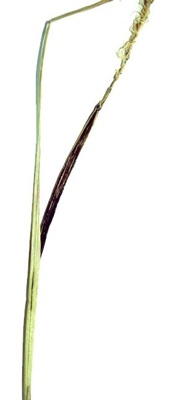Diseases
Urocystis occulta (Wallr.) Rab. - Flag Smut of Rye.
Systematic position.
Class Basidiomycetes, subclass Teliobasidiomycetidae (= Sclerobasidiomycetidae), oder Ustilaginales, family Tilletiaceae, genus Urocystis.Biological group.
Biotroph.Morphology and biology.
Urocystis occulta infects species of Secale and Elymus. Leaves are twisted laterally, giving the appearance of herbicide injury, and heading may be prevented. Lesions may appear on plants of all ages, usually in 40 days at booting and ear emergence. Diseased plants are stunted, producing excessive numbers of tillers. Being usually systemic, the infection affects normally all tillers. Occasionally, only isolated tillers are affected. At heading, the long gray-black streaks develop between veins on leaf blades and sheaths. Those streaks have a greasy appearance. The stripes represent individual spore-producing sori. The sori crack to release the teliospore mass, resulting in ragged tattered leaves. Spores mass consists of spherical or elliptic glomerules being 14.4-35.5 to 11.2-26.3 .m in size. The glomerules enclose 1 to 3-4 teliospores surrounded with 1-9 sterile cells. Teliospores may be released from infected plants by harvesting operations, being mixed with seeds in the harvester. The fungus keeps as teliospores on seed surface. On the soil the spores lose germinating capacity in one year. Soon after seed germination the basidiospores fuse and the infectious hyphae infects the coleoptile prior to emergence. After seedling emergence the plant is not sensitive to the disease. The fungus over-winters as mycelium in seedlings, then it systemically invades and sporulates within the upper plant parts.Distribution.
Disease is registered in different countries of Europe, Asia, America, and in Australia. In former USSR it is found everywhere, mainly in northern regions of the European part, in Siberia and the Far East.Ecology.
Disease is distributed in the northern part of the host area, especially in the zone of temperate climate. Teliospores germinate at temperature 5 to 25., optimum 13-17.C. At temperature 10.C and lower the infection process slows down. Optimum soil humidity is 25-35%, and higher humidity detains spores germination. The alkalinity pH = 6.8 is optimum for successful spores germination that is also possible at pH = 4-8. Temperature 22-27.C and relative humidity 56-85% is most favorable for spores germination and mycelium growth.Economic significance.
Disease is potentially dangerous. The damage consists both of direct losses and losses connected with depression of outwardly healthy plants. The total losses may reach 20% of yield at the disease incidence to 0.5%. Control measures include as follows. Shallow planting is better than deep planting to reduce infection. It is necessary to use seeds treatment by systemic fungicides, crop rotation, and mineral fertilizer according to agrochemical analyses of soil.Related references:
Anon. 1999. Smuts of rye, oats and barley. Zashchita rastenii i karantin. 7: p. 31 (in Russian).Ishkova, T.I., Berestetskaya, L.I., Gasich, E.L., Levitin, M.M. & Vlasov, D.Yu. 2002. Diagnostics of the main fungus diseases of cereal crops. St. Petersburg: VIZR. 76 p. (in Russian).
Kalashnikov, K.Ya. 1973. Severity of rye flag smut. Zashchita rastenii. 12: p. 50 (in Russian).
Karatygin, I.V. 1986. Smuts of cereal crops. Leningrad: Nauka. 112 p. (in Russian).
Levitin, M.M. & Tyuterev, S.L. 2003. Fungal diseases of cereals crops. Zashchita rastenii i karantin. 11: 77 (in Russian).
© Dmitriev A.P.


